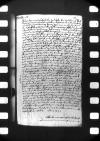 BCz, 1606, p. 207
BCz, 1606, p. 207
Hochwirdiger in Got, fielgeliebter und lieber her und freunde.
Nach erpitung meiner gantz freuntlichen dinst, wes ich auch iederzeit mer liebs und gutes vermag zuvor.
Wer mir ein sundre freud, so E(uer) L(ieb) gluckselig gesunt und allenthalben mit gutem abschid widerumb anheimbs kumen und so es mir zu fertrawen E(uer) L(ieb) gezune(n) wolt, het ich auch wol ein verlangen sollichs zuwissen, bevor auch von der perso(n) E(uer) L(ieb) von unnoten zuerkleren, quia intelligenti satis etc. Zum ander(n) weil sich E(uer) L(ieb) und andre stend aus befelich ⌊k(onigliche) ma(ieste)t⌋ widerumb bedaget, auch wissens haben, wes ich in der swedischen sach k(onigliche) ma(ieste)t zumb peste(n) furgetrage(n), wo es nun E(uer) L(ieb) und andre gerate(n) deucht, / nochmols disen landen zu gut etwas darvo(n) zubedencken, wolt ich E(uer) L(ieb) trewlich gepeten haben, weil michs an unssers hern hoff schir ansicht, als ob man der ⌊Preussen⌋ wenig acht, E(uer) L(ieb) wel doch der kronne(n) und aller irer klid(en) pestes zutrachten und raten nicht untterlassen, sunderlich auch fleis furwenden, das wir doch in den landen Preussen gute policey haben mochten, dy tewerung des hantwerckmans und gesindes, domit doch ein piderman widerumb zu gesund kume(n) mocht und guter policey mer anhengich auch auff disem dag bedacht mocht werden.
Ich pin hir, Got lob, mit den meine(n) in zimlicher gesunt ankume(n) aber meine(n) freunt nicht anheimbs funden. So sein mir zeitung untterwege(n) zukume(n), wy dy in ⌊Kopenhage(n)⌋ hart uneins, den dy purger wollen erwelte ⌊k(onigliche) w(irde)⌋ zu eine(m) kunig habe(n), dy knecht sein in aber ubermant und sol der ⌊graff⌋ pis auff zukunft k(onigliche) w(irde), welche pey k(oniglicher) w(irde) zu ⌊Sweden⌋ ist, dy sach gestelt haben sollicher gestalt, so k(onigliche) w(irde) in lager kumb, das dy purger handeln sollen, das er mit seiner hab und gut abzihen moge. Es hat auch das gantz land ⌊Parnholom⌋ k(oniglicher) w(irde) sich ergewen und gesworen, des haben k(oniglicher) w(irde) krigsrete etzlich schiff sampt eine(m) denischen edelma(n) an den haubtman auff dem schlos abgefertigt zuerfare(n), was er pey k(oniglicher) w(irde) thu(n) wol, auch ob das landt ⌊Stenburg⌋ bedorfte, es hat aber der stur(m) wint dy schiff versetzt und nemer 2 als eulen und lewen mit zuprechung mest segel, verlisung ancker traw, zuprechu(n)g der pot, eins ken ⌊Dantzig⌋, das ander ⌊Kunigspurgk⌋ gesetzt, Got geb weiter zu gnad. E(uer) L(ieb) wol dise zeitung hern ⌊Jorge(n) von Pasen⌋, ⌊Zeme(n)⌋ und ⌊Johan von Werden⌋ auch mittheilen.
⌊Mein lieb gemahel⌋ thut E(uer) L(ieb) ser grussen, wolt gern E(uer) L(ieb) gestalt einmol sehen. Befelen hiemit E(uer) L(ieb) Cristo und uns der selben.
Datu(m) in eile, ⌊Helspergk⌋, den 1 Octobris / anno 1535.
⌊Albrecht marggraff und hertzog⌋ etc.


 BCz, 1606, p. 210
BCz, 1606, p. 210